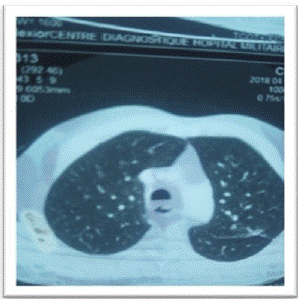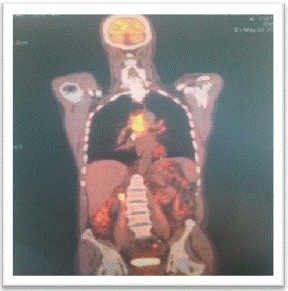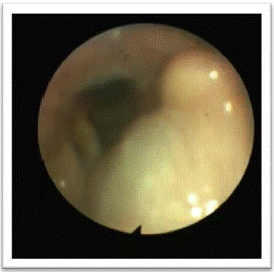
Case Report
Austin Med Sci. 2023; 8(1): 1073.
Synchronous Laryngeal Primary Cancer in a Patient with Esophageal Squamous Carcinoma Cell: A Case Report
Ouhammou Y*; Gridda M; Maouni I; Yaka M; Njoumi N; Zentar A; Ait Ali A
Department of Visceral Surgery, Military Hospital Mohammed V, Faculty of Medicine and Pharmacy of Rabat, Morocco
*Corresponding author: Ouhammou Y Department of Visceral Surgery, Military Hospital Mohammed V, Faculty of Medicine and Pharmacy of Rabat, Morocco. Email: ouhammouyousra2017@gmail.com
Received: March 31, 2023 Accepted: May 05, 2023 Published: May 12, 2023
Abstract
Unexpected diagnosis of primary synchronous cancer in a patient with esophageal squamous carcinoma cell makes therapeutic management difficult. The careful evaluation of synchronous tumors is a primority aspect of management. we present the unusual case of an individual with esophageal squamous carcinomas cell synchronously associated with another primary laryngeal tumor. Initial clinical assessment was performed and consisting in a pan endoscopy and FDG-Pet scan / CT revealed the presence of Synchronous Head and Neck and Esophageal Carcinoma (SHNEC). As recommended in the literature, surgical resection was not indicated. In this case radio chemotherapy often remains the only therapeutic alternative which guarantees a better result and improves the prognosis. The patient progressed well under concomitant radio chemotherapy even if complications inherent to this treatment required the cessation of treatment for a short period.
Keywords: Synchrounos squamous cell carcinoma; Radio chemotherapy
Introduction
Synchronous esophageal and laryngeal Squamous Cell Carcinoma (SCC) have been increasing due at improvements diagnostic technique [1]. The association between different SCC can be explained by chronic exposition to common carcinogens agents “tobacco and alcoholism” [2], This exposition responds to the concept of (the field cancerization) induced tumor formation through DNA methylation and epigenetic alteration The incidence of esophageal and laryngeal squamous cell carcinoma in morocco is approximately 1,2% [3] the presence of simultaneously malignancy of the upper aero-digestive is a critical aspect of diagnosis and management; however, this is facilitated by the advent of the FDG-PET scan and panendoscopy standard modality of staging and diagnosis.
Therapeutically, Curative Chemoradiotherapy (CCRT) is best alternative treatment of synchronous SCC locally advanced and non operable tumors, the surgical treatment endowed death complication, unfortunately CRT necessity the delivery of high dose radiation causing the tissue toxicity. SCC with early involvement lymph node renders it extremely aggressive with a high mortality.
Case Report
A 62 years old man, having as risk factors a regular consumption of tobacco and alcohol, without notion of hereditary disease. He presented to the gastroenterology department complaining of progressive dysphagia for solid foods and hoarseness of the voice for 2 months, with weight loss for 4 months. Physical examination revealed general cachexia with no other physical signs. Laboratory results showed mild anemia with a hemoglobin of 9.6g/dl, serum tumor markers (scc, cyfra 21-1) were elevated. Gastroduodenoscopy of the esophagus revealed an irregular circumferential ulcerative lesion located 35 cm from the dental arch. Naso pharyngo endoscopy revealed a left subglottic laryngeal tumor mass. Thoraco-abdominal CT scan showed a circumferential thickening of the thoracic esophagus with a height of 70 mm from the subcarinal region and measuring 15mm in thickness, with several pulmonary aortic and left intrabronchial Hilar lymph nodes measuring (20/6 mm). In addition, at the cervical level, CT imaging showed a polyploid mass; CT-AP imaging: no secondary metastasis (Figure 1); FDG-PET/CT (Figure 2): demonstrates focal intense FDG avidity over the esophagus, left epiglottis and mediastinal lymph nodes. The diagnosis of squamous cell carcinoma of the esophagus and larynx was confirmed by histopathology.

Figure 1: CT showed circumferential thickening of the thoracic esophagus with several lymadenopathy.

Figure 2: The FDG-PET/CT detected two focal lesions one is hypermetabolic and the other have a discrete activity.

Figure 3: Naso fibroscopic examination discovered a tumor process at the level of epiglottis base.
The therapeutic decision was to perform radiotherapy and chemotherapy with gastrostomy feeding. The patient received this dose of radiotherapy which was distributed over 7 cycles, one day per week, these doses were prescribed according to a volume scheme: 50 GY for the esophageal lesion and 70 GY for the supraglottic process. Simultaneously, we incorporated chemotherapy: cisplatin (25mg) and Docetaxel 25mg weekly for 8 cycles.
The patient was regularly examined with clinical and imaging examinations (CT and endoscopy) for one year, but the result was not satisfactory, unfortunately the patient died during the treatment.
Discussion
The patient with (esophageal SCC) has an increased risk to develop a synchronous tumor in the aerodigestive tract organs such a larynx, pharynx, and lung, and this tumor is frequently recognized in the developing countries because of the systematic search for any esophageal neoplasic localization.
The incidence of esophagus and laryngeal SCC is extremely rare in our context because of screening deficiencies management strategies by default of modern diagnostic means for these patients.
Recently the FDG-PET scan and panendoscopy are the standard modality to diagnosis and demonstrating and staging the synchronous cancers with 100 sensitivity and 89 specificity for endoscopy; and 91 sensitivity and 69 positive predictive values for the FDG-PET SCAN [5].
The combination of esophagus and laryngeal SCC is one of the biggest problems for therapeutic determination. Several factors must be incriminated to detect this disease (especially tobacco and alcohol) [6]. In order to have a particularly suitable curative strategy when surgery is involved in this process. In all cases, the curability of these tumors must be evaluated after careful staging [7].
If these 2 tumors are potentially curable, each lesion must be treated individually as if it was a distinction and primary lesion, on the other hand, we must take into consideration the general state of the patient, the co-morbidities and life quality especially after an invasively treat CRT [8].
Simultaneous final CRT treatment was difficult by exposure to a broad range of ionizing radiation. We have adopted this treatment despite its aggressiveness since numerous studies show its effectiveness [9,10,4].
In a Japanese study MASARU MORITA [5] showed that all Head and Neck Carcinoma (HNC) stage I, lesions had complete remission after this treatment, where as this response was only 67% for the same stage in the esophagus.
However, the surgical treatment also applied salvage treatment that is indicated in case of recurrence after remission or residual tumor persistence, it is the total pharyngo laryngo-esophagectomy that is reported as much as a high-risk surgery with a mortality of 22% and a morbidity of 44%, which must be carefully programmed and implemented in reference centers of excellence [12].
There are various strategies to treat patient with esophageal and laryngeal SCC including different therapeutic options: chemotherapy radiotherapy and surgery [5]. CRT study was successful in 44% of the patients, which proves the effectiveness of this therapeutic process for this dual localization of squamous cell carcinoma. Then in the same study when surgical resection with reconstruction was adopted for this type of tumor was extremely invasive and complicated the evolution was marked by an impairment of phonation and swallowing with high mortality.
Therapeutically the curative concurrent chemo radiotherapy CCRT remains the alternative choice used to treat patient with synchrony tumors, in the past surgical treatment was in alternative way for this type of cancer, but a lot of studies explain that the outcomes of this was very poor. The causes of this poor prognosis are related to the general conditions of the rate of complication and difficulty of operation like our patient. Additionally, the recent improvement showed the superiority of neo adjuvant RCT compared to radical surgery [12].
Conclusion
The presence of synchronous squamous cell carcinoma of esophageal and laryngeal is one of the most significant problems in determining the treatment strategy, multiple factors must be considered for a better treatment strategy, the FDG-PET SCAN and panendoscopy remains the best means for exploring synchronous tumors and hidden malignancy.
References
- Slaughter DP, Southwick HW, Smejkal W. Field cancerization in oral stratified squamous epithelium: clinical implications of multicentric origin. Cancer. 1953; 6: 963-8.
- Strong MS, Incze J, Vaughan CW. Field cancerization in the aerodigestive tract: its etiology, manifestation, and significance. J Otolaryngol. 1984; 13: 1-6.
- MAAMRI.A donnes épidémiologiques sur les cancers dans le monde et du maroc revue bibliographique, annales de sciences de la santé, N°1,20-29. 2015.
- Chen YH, Lu HI, Chien CY, Lo CM, Su YY, et al. Treatment Outcomes of Patients with Locally Advanced Synchronous Esophageal and Head/Neck Squamous Cell Carcinoma Receiving Curative Concurrent Chemoradiotherapy. Sci Rep. 2017; 7: 41785.
- Morita M, Egashira A, Nakaji Y, Kagawa M, Sugiyama M, et al. Treatment of squamous cell carcinoma of the esophagus synchronously asso-ciated with head and neck cancer. In Vivo. 2017; 31: 909–16.
- Ishimori T, Patel PV, Wahl RL. Detection of unexpected additional primary malignancies with PET/CT. J Nucl Med. 2005; 46: 752-7.
- Li QW, Zhu YJ, Zhang WW, Yang H, Liang Y, et al. Chemoradiotherapy for synchronous multiple primary cancers with esopha-geal squamous cell carcinoma: a case-control study. J Cancer. 2017; 8: 563–9.
- Lee JS, Ahn JY, Choi KD, Song HJ, Kim YH, et al. Synchronous second primary cancers in patients with squamous esophageal cancer: clinical features and survival outcome. Korean J Intern Med. 2016; 31: 253–9.
- Shinoto M, Shioyama Y, Sasaki T, Nakamura K, Ohura H, et al. Clinical resultats of definitive chemoradiotherapy for patients with synchronous head and neck squamous cell carcinoma and esophageal cancer. Am J Clin Oncol. 2011; 362-366.
- Chen Y, Chang JY, Jeter M, Guerrero T, Ajani J, et al. Esophageal cancer located at the neck and upper thorax treated with concurrent chemoradiation: single-institution experience. J Thorac Oncol. 2006; 1: 252–9.
- Niwa Y, Koike M. Salvage pharyngolaryngectomy. Dis Esophagus. 2016; 29: 598-602.
- Ordu AD, Nieder C. Association between radiation dose and pathological complete response after preoperative radiochemotherapy in esophageal squamous cell cancer. Anticancer Res. 2014; 34: 7255-7261.